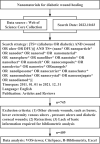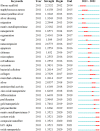Nanomaterials for diabetic wound healing: Visualization and bibliometric analysis from 2011 to 2021
- PMID: 36761188
- PMCID: PMC9905413
- DOI: 10.3389/fendo.2023.1124027
Nanomaterials for diabetic wound healing: Visualization and bibliometric analysis from 2011 to 2021
Abstract
Background: Nanomaterials have recently been shown to have a considerable advantage in promoting wound healing in diabetic patients or animal models. However, no bibliometric analysis has been conducted to evaluate global scientific production. Herein, this study aimed to summarize the current characteristics, explore research trends, and clarify the direction of nanomaterials and diabetic wound healing in the future.
Methods: Relevant publications from 2011 to 2021 were collected from the Web of Science Core Collection on October 3, 2022. VOSviewer, CiteSpace, bibliometrix-R package, Origin 2021, and Microsoft Excel 2019 were used for bibliometric and visualization analyses.
Results: We identified 409 publications relating to nanomaterials and diabetic wound healing. The number of annual productions remarkably increased from 2011 to 2021, with China and Shanghai Jiao Tong University being the most productive. The most prolific authors were Hasan Anwarul. The leading journal was the International Journal of Biological Macromolecules, with 22 publications. The most popular keywords were "nanoparticles," "delivery," "in vitro," "electrospinning," "angiogenesis," and "antibacterial." Keyword burst analysis showed "cerium oxide," "matrix metalloproteinase 9," "composite nanofiber," "hif 1 alpha," and "oxide nanoparticle" were emerging research hotspots.
Conclusion: We found there has been a great progress in the application of nanomaterials in diabetic wound healing from 2011 to 2021. Although many researchers and institutions from different countries or regions contributed contributed to publications, it will be helpful or the development of this field if the degree of international cooperation can be enhanced. In the future, nanomaterials with powerful antioxidant and antibacterial qualities and promoting angiogenesis are the research hotspots.
Keywords: bibliometric; diabetic non-healing wound; knowledge map; research trends; web of science.
Copyright © 2023 Zhang, Liu, Che, Zheng, Nan and Wu.
Conflict of interest statement
The authors declare that the research was conducted in the absence of any commercial or financial relationships that could be construed as a potential conflict of interest.
Figures










Similar articles
-
Research trends on nanomaterials in gastric cancer: a bibliometric analysis from 2004 to 2023.J Nanobiotechnology. 2023 Aug 2;21(1):248. doi: 10.1186/s12951-023-02033-8. J Nanobiotechnology. 2023. PMID: 37533041 Free PMC article. Review.
-
Research hotspots and trends of nanomaterials in stomatology: A bibliometric analysis from 2000 to 2023.Heliyon. 2024 Mar 13;10(6):e27967. doi: 10.1016/j.heliyon.2024.e27967. eCollection 2024 Mar 30. Heliyon. 2024. PMID: 38545160 Free PMC article.
-
Research Trends and Developments in Nanomaterials for Rheumatoid Arthritis: A Comprehensive Bibliometric Analysis.Drug Des Devel Ther. 2025 May 27;19:4355-4371. doi: 10.2147/DDDT.S514898. eCollection 2025. Drug Des Devel Ther. 2025. PMID: 40453210 Free PMC article.
-
The research status and prospects of nanomaterials in wound healing: A scientometric study.Medicine (Baltimore). 2024 Mar 15;103(11):e37462. doi: 10.1097/MD.0000000000037462. Medicine (Baltimore). 2024. PMID: 38489685 Free PMC article.
-
Global trends and hotspots of treatment for nonalcoholic fatty liver disease: A bibliometric and visualization analysis (2010-2023).World J Gastroenterol. 2023 Oct 7;29(37):5339-5360. doi: 10.3748/wjg.v29.i37.5339. World J Gastroenterol. 2023. PMID: 37899789 Free PMC article. Review.
Cited by
-
Visualizing the global trends of peptides in wound healing through an in-depth bibliometric analysis.Int Wound J. 2024 Apr;21(4):e14575. doi: 10.1111/iwj.14575. Epub 2023 Dec 20. Int Wound J. 2024. PMID: 38116897 Free PMC article.
-
Global research trends of nanomaterials application in periodontitis and peri-implantitis: A bibliometric analysis.Heliyon. 2024 Aug 13;10(16):e36187. doi: 10.1016/j.heliyon.2024.e36187. eCollection 2024 Aug 30. Heliyon. 2024. PMID: 39224328 Free PMC article.
-
Neuroprotective Effects and Mechanisms of Alpiniae oxyphyllae Fructus, a Medicinal and Edible Homologous Herb: Research Advances.Int J Mol Sci. 2025 Jun 27;26(13):6230. doi: 10.3390/ijms26136230. Int J Mol Sci. 2025. PMID: 40650004 Free PMC article. Review.
-
Global Status and Future Trends of Fascia and Pain Research in 2013-2022: Bibliometric Analysis Based on CiteSpace and VOSviewer.J Pain Res. 2023 Jul 28;16:2633-2653. doi: 10.2147/JPR.S412161. eCollection 2023. J Pain Res. 2023. PMID: 37538250 Free PMC article.
-
Research trends of acupuncture therapy on stress urinary incontinence from 1992 to 2022: A bibliometric analysis.Heliyon. 2023 Sep 1;9(9):e19732. doi: 10.1016/j.heliyon.2023.e19732. eCollection 2023 Sep. Heliyon. 2023. PMID: 37810054 Free PMC article. Review.
References
Publication types
MeSH terms
Substances
LinkOut - more resources
Full Text Sources
Medical

